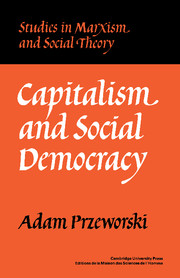Book contents
- Frontmatter
- Contents
- Acknowledgments
- Introduction
- 1 Social Democracy as a Historical Phenomenon
- 2 Proletariat into a Class: The Process of Class Formation
- 3 Party Strategy, Class Organization, and Individual Voting
- 4 Material Bases of Consent
- 5 Material Interests, Class Compromise, and the State
- 6 Democratic Capitalism at the Crossroads
- 7 Exploitation, Class Conflict, and Socialism: The Ethical Materialism of John Roemer
- Postscript: Social Democracy and Socialism
- References
- Name Index
- Subject Index
1 - Social Democracy as a Historical Phenomenon
Published online by Cambridge University Press: 05 June 2012
- Frontmatter
- Contents
- Acknowledgments
- Introduction
- 1 Social Democracy as a Historical Phenomenon
- 2 Proletariat into a Class: The Process of Class Formation
- 3 Party Strategy, Class Organization, and Individual Voting
- 4 Material Bases of Consent
- 5 Material Interests, Class Compromise, and the State
- 6 Democratic Capitalism at the Crossroads
- 7 Exploitation, Class Conflict, and Socialism: The Ethical Materialism of John Roemer
- Postscript: Social Democracy and Socialism
- References
- Name Index
- Subject Index
Summary
The Decision to Participate
The crucial choice was whether to participate. Earlier events resulted in establishing the principle of democracy in the political realm. Yet political rights were merely formal when accompanied by the compulsion and inequality that reigned in the social realm. As it emerged around 1850, socialism was thus a movement that would complete the revolution started by the bourgeoisie by wresting from it “social power” just as the bourgeoisie had conquered political power. The recurrent theme of the socialist movement ever since has been this notion of “extending” the democratic principle from the political to the social in effect primarily economic, realm.
Yet precisely because the principle of democracy was already present in the political institutions, the means by which socialism would be achieved appeared as a choice. The project of the early, communitarian, socialists was to build a society within the society, a community of immediate producers associated in workshops and manufactures, cooperating as consumers and administering their own affairs. This society of associated producers was to be built in complete independence of the bourgeois world; it was simply to by-pass the emerging capitalist, and to a great extent industrial, order. Yet as soon as the new bourgeois society developed its political institutions – first the bureaucracy and the standing army and then the popularly elected parliament – the posture of aloof independence could not be sustained.
- Type
- Chapter
- Information
- Capitalism and Social Democracy , pp. 7 - 46Publisher: Cambridge University PressPrint publication year: 1985
- 3
- Cited by



